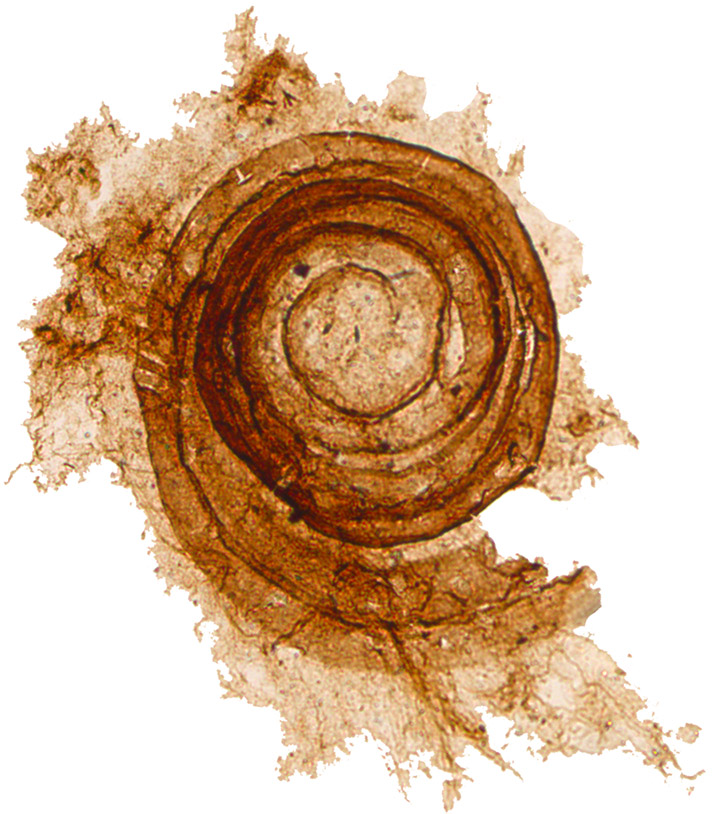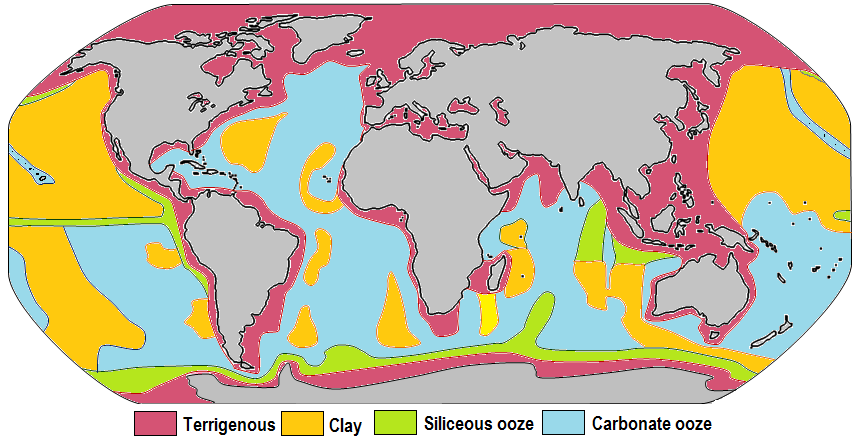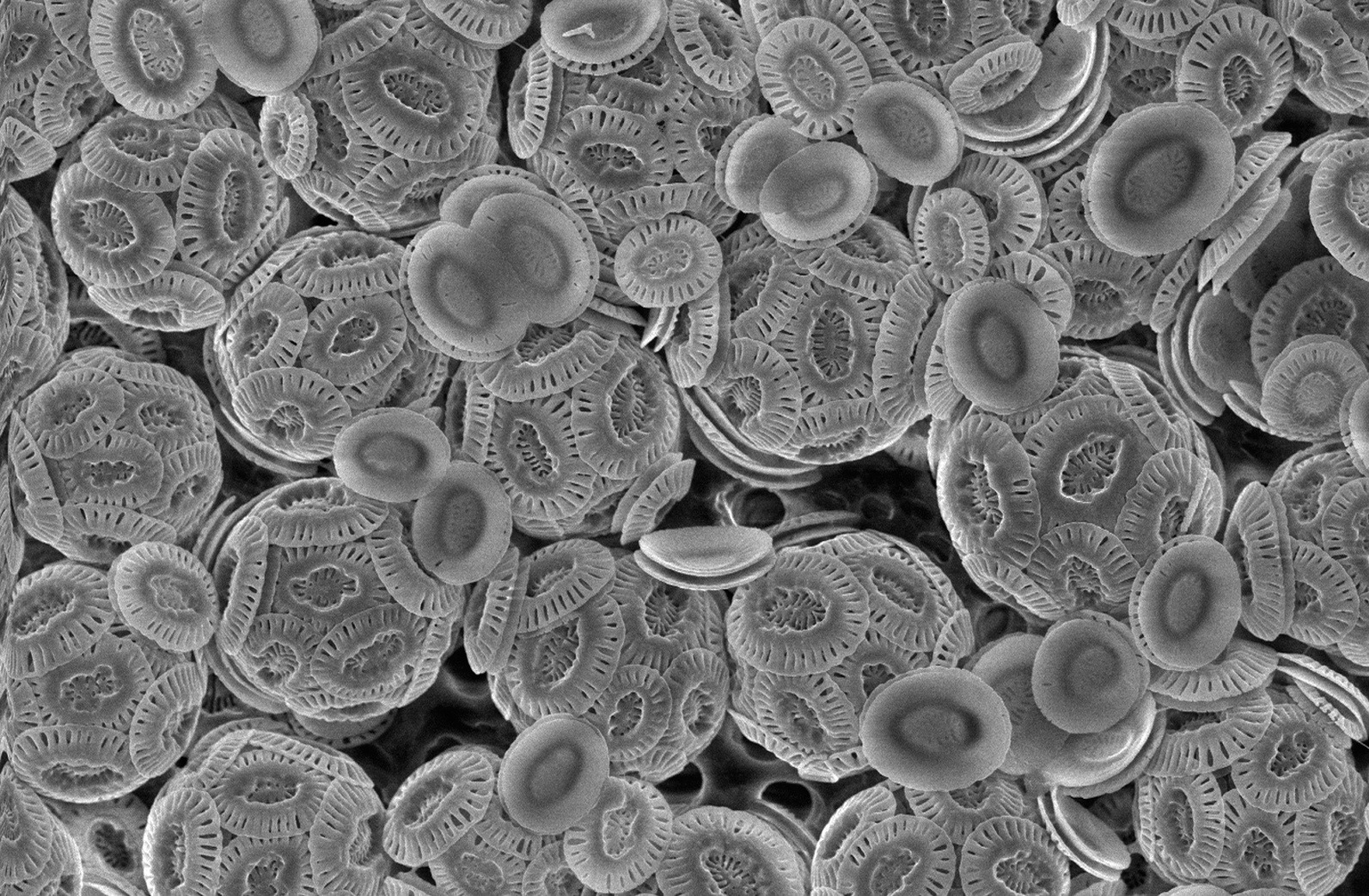|
Micro-fossil
A microfossil is a fossil that is generally between 0.001 mm and 1 mm in size, the visual study of which requires the use of light or electron microscopy. A fossil which can be studied with the naked eye or low-powered magnification, such as a hand lens, is referred to as a macrofossil. Microfossils are a common feature of the geological record, from the Precambrian to the Holocene. They are most common in deposits of marine environments, but also occur in brackish water, fresh water and terrestrial sedimentary deposits. While every kingdom of life is represented in the microfossil record, the most abundant forms are protist skeletons or microbial cysts from the Chrysophyta, Pyrrhophyta, Sarcodina, acritarchs and chitinozoans, together with pollen and spores from the vascular plants. Overview A microfossil is a descriptive term applied to fossilized plants and animals whose size is just at or below the level at which the fossil can be analyzed by the naked eye ... [...More Info...] [...Related Items...] OR: [Wikipedia] [Google] [Baidu] |
Cochleatina
''Cochleatina'' is an organic-walled microfossil ('Small Carbonaceous Fossil') known from the late Ediacaran period and early Cambrian Fortunian The Fortunian age marks the beginning of the Phanerozoic Eon, the Paleozoic Era, and the Cambrian Period. It is the first of the two stages of the Terreneuvian series. Its base is defined as the first appearance of the trace fossil ''Treptichnus p ... Stage. ''Cochleatina'' comprises a complex spiral ribbon structure, with a serrated outer margin. These spirals are frequently found embedded in an organic sheet. ''Cochleatina'' is a rare example of a fossil taxon known to span the Ediacaran–Cambrian boundary. Affinity ''Cochleatina's'' biological affinity is unknown. It has been variously regarded as the fossil remains of an animal, an algae, or a protist. References Incertae sedis Ediacaran life {{cambrian-stub ... [...More Info...] [...Related Items...] OR: [Wikipedia] [Google] [Baidu] |
Chitinozoa
Chitinozoa (singular: chitinozoan, plural: chitinozoans) are a group of flask-shaped, organic walled marine microfossils produced by an as yet unknown organism. Common from the Ordovician to Devonian periods (i.e. the mid-Paleozoic), the millimetre-scale organisms are abundant in almost all types of marine sediment across the globe. This wide distribution, and their rapid pace of evolution, makes them valuable biostratigraphic markers. Their bizarre form has made classification and ecological reconstruction difficult. Since their discovery in 1931, suggestions of protist, plant, and fungal affinities have all been entertained. The organisms have been better understood as improvements in microscopy facilitated the study of their fine structure, and it has been suggested that they represent either the eggs or juvenile stage of a marine animal. However, recent research has suggested that they represent the hard shell of a group of protists with uncertain affinities. Chitinozoan ec ... [...More Info...] [...Related Items...] OR: [Wikipedia] [Google] [Baidu] |
Dinoflagellate
The dinoflagellates (Greek δῖνος ''dinos'' "whirling" and Latin ''flagellum'' "whip, scourge") are a monophyletic group of single-celled eukaryotes constituting the phylum Dinoflagellata and are usually considered algae. Dinoflagellates are mostly marine plankton, but they also are common in freshwater habitats. Their populations vary with sea surface temperature, salinity, and depth. Many dinoflagellates are photosynthetic, but a large fraction of these are in fact mixotrophic, combining photosynthesis with ingestion of prey (phagotrophy and myzocytosis). In terms of number of species, dinoflagellates are one of the largest groups of marine eukaryotes, although substantially smaller than diatoms. Some species are endosymbionts of marine animals and play an important part in the biology of coral reefs. Other dinoflagellates are unpigmented predators on other protozoa, and a few forms are parasitic (for example, ''Oodinium'' and ''Pfiesteria''). Some dinoflagellates pro ... [...More Info...] [...Related Items...] OR: [Wikipedia] [Google] [Baidu] |
Protist Shell
Many protists have protective shells or tests, usually made from silica (glass) or calcium carbonate (chalk). Protists are mostly single-celled and microscopic. Their shells are often tough, mineralised forms that resist degradation, and can survive the death of the protist as a microfossil. Although protists are typically very small, they are ubiquitous. Their numbers are such that their shells play a huge part in the formation of ocean sediments and in the global cycling of elements and nutrients. Overview Cellular life likely originated as single-celled prokaryotes (including modern bacteria and archaea) and later evolved into more complex eukaryotes. Eukaryotes include organisms such as plants, animals, fungi and "protists". Protists are usually single-celled and microscopic. The term protist came into use historically to refer to a group of biologically similar organisms; however, modern research has shown it to be a paraphyletic group that does not contain all descen ... [...More Info...] [...Related Items...] OR: [Wikipedia] [Google] [Baidu] |
Marine Protists
Marine protists are defined by their habitat as protists that live in Marine habitat, marine environments, that is, in the saline water, saltwater of seas or oceans or the brackish water of coastal Estuary, estuaries. Life originated as marine Marine prokaryotes, single-celled prokaryotes (bacteria and archaea) and later evolved into Eukaryote, more complex eukaryotes. Eukaryotes are the more developed life forms known as plants, animals, fungi and protists. Protists are the eukaryotes that cannot be classified as plants, fungi or animals. They are mostly single-celled and microscopic. The term protist came into use historically as a term of convenience for eukaryotes that cannot be strictly classified as plants, animals or fungi. They are not a part of modern cladistics because they are paraphyletic (lacking a common ancestor for all descendants). Most protists are too small to be seen with the naked eye. They are highly diverse organisms currently organised into 18 phyla, but ... [...More Info...] [...Related Items...] OR: [Wikipedia] [Google] [Baidu] |
Marine Sediment
Marine sediment, or ocean sediment, or seafloor sediment, are deposits of insoluble particles that have accumulated on the seafloor. These particles have their origins in soil and rocks and have been transported from the land to the sea, mainly by rivers but also by dust carried by wind and by the flow of glaciers into the sea. Additional deposits come from marine organisms and chemical precipitation in seawater, as well as from underwater volcanoes and meteorite debris. Except within a few kilometres of a mid-ocean ridge, where the volcanic rock is still relatively young, most parts of the seafloor are covered in sediment. This material comes from several different sources and is highly variable in composition. Seafloor sediment can range in thickness from a few millimetres to several tens of kilometres. Near the surface seafloor sediment remains unconsolidated, but at depths of hundreds to thousands of metres the sediment becomes lithified (turned to rock). Rates of sediment ... [...More Info...] [...Related Items...] OR: [Wikipedia] [Google] [Baidu] |
Spore
In biology, a spore is a unit of sexual or asexual reproduction that may be adapted for dispersal and for survival, often for extended periods of time, in unfavourable conditions. Spores form part of the life cycles of many plants, algae, fungi and protozoa. Bacterial spores are not part of a sexual cycle, but are resistant structures used for survival under unfavourable conditions. Myxozoan spores release amoeboid infectious germs ("amoebulae") into their hosts for parasitic infection, but also reproduce within the hosts through the pairing of two nuclei within the plasmodium, which develops from the amoebula. In plants, spores are usually haploid and unicellular and are produced by meiosis in the sporangium of a diploid sporophyte. Under favourable conditions the spore can develop into a new organism using mitotic division, producing a multicellular gametophyte, which eventually goes on to produce gametes. Two gametes fuse to form a zygote which develops into a new s ... [...More Info...] [...Related Items...] OR: [Wikipedia] [Google] [Baidu] |
Biostratigraphy
Biostratigraphy is the branch of stratigraphy which focuses on correlating and assigning relative ages of rock Stratum, strata by using the fossil assemblages contained within them.Hine, Robert. “Biostratigraphy.” ''Oxford Reference: Dictionary of Biology'', 8th ed., Oxford University Press, 2019. The primary objective of biostratigraphy is ''correlation'', demonstrating that a particular Horizon (geology), horizon in one geological section represents the same period of time as another horizon at a different section. Fossils within these strata are useful because sediments of the same age can look completely different, due to local variations in the Sedimentary depositional environment, sedimentary environment. For example, one section might have been made up of clays and marls, while another has more chalky limestones. However, if the fossil species recorded are similar, the two sediments are likely to have been laid down around the same time. Ideally these fossils are used to ... [...More Info...] [...Related Items...] OR: [Wikipedia] [Google] [Baidu] |
Paleoclimatology
Paleoclimatology (British spelling, palaeoclimatology) is the study of climates for which direct measurements were not taken. As instrumental records only span a tiny part of Earth's history, the reconstruction of ancient climate is important to understand natural variation and the evolution of the current climate. Paleoclimatology uses a variety of proxy methods from Earth and life sciences to obtain data previously preserved within rocks, sediments, boreholes, ice sheets, tree rings, corals, shells, and microfossils. Combined with techniques to date the proxies, the paleoclimate records are used to determine the past states of Earth's atmosphere. The scientific field of paleoclimatology came to maturity in the 20th century. Notable periods studied by paleoclimatologists are the frequent glaciations that Earth has undergone, rapid cooling events like the Younger Dryas, and the rapid warming during the Paleocene–Eocene Thermal Maximum. Studies of past changes in the environm ... [...More Info...] [...Related Items...] OR: [Wikipedia] [Google] [Baidu] |
Palynology
Palynology is the "study of dust" (from grc-gre, παλύνω, palynō, "strew, sprinkle" and '' -logy'') or of "particles that are strewn". A classic palynologist analyses particulate samples collected from the air, from water, or from deposits including sediments of any age. The condition and identification of those particles, organic and inorganic, give the palynologist clues to the life, environment, and energetic conditions that produced them. The term is commonly used to refer to a subset of the discipline, which is defined as "the study of microscopic objects of macromolecular organic composition (i.e., compounds of carbon, hydrogen, nitrogen and oxygen), not capable of dissolution in hydrochloric or hydrofluoric acids". It is the science that studies contemporary and fossil palynomorphs (paleopalynology), including pollen, spores, orbicules, dinocysts, acritarchs, chitinozoans and scolecodonts, together with particulate organic matter (POM) and kerogen found in sedimen ... [...More Info...] [...Related Items...] OR: [Wikipedia] [Google] [Baidu] |
Coccolithophore
Coccolithophores, or coccolithophorids, are single celled organisms which are part of the phytoplankton, the autotrophic (self-feeding) component of the plankton community. They form a group of about 200 species, and belong either to the kingdom Protista, according to Robert Whittaker's Five kingdom classification, or clade Hacrobia, according to a newer biological classification system. Within the Hacrobia, the coccolithophores are in the phylum or division Haptophyta, class Prymnesiophyceae (or Coccolithophyceae). Coccolithophores are almost exclusively marine, are photosynthetic, and exist in large numbers throughout the sunlight zone of the ocean. Coccolithophores are the most productive calcifying organisms on the planet, covering themselves with a calcium carbonate shell called a ''coccosphere''. However, the reasons they calcify remains elusive. One key function may be that the coccosphere offers protection against microzooplankton predation, which is one of the ma ... [...More Info...] [...Related Items...] OR: [Wikipedia] [Google] [Baidu] |
Foraminifera
Foraminifera (; Latin for "hole bearers"; informally called "forams") are single-celled organisms, members of a phylum or class of amoeboid protists characterized by streaming granular Ectoplasm (cell biology), ectoplasm for catching food and other uses; and commonly an external shell (called a "Test (biology), test") of diverse forms and materials. Tests of chitin (found in some simple genera, and Textularia in particular) are believed to be the most primitive type. Most foraminifera are marine, the majority of which live on or within the seafloor sediment (i.e., are benthos, benthic), while a smaller number float in the water column at various depths (i.e., are planktonic), which belong to the suborder Globigerinina. Fewer are known from freshwater or brackish conditions, and some very few (nonaquatic) soil species have been identified through molecular analysis of small subunit ribosomal DNA. Foraminifera typically produce a test (biology), test, or shell, which can have eithe ... [...More Info...] [...Related Items...] OR: [Wikipedia] [Google] [Baidu] |








